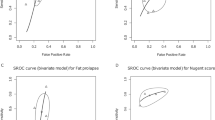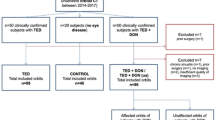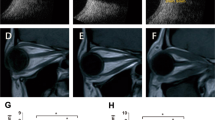Abstract
Purpose
To assess the association of optic nerve sheath (ONS) infiltration, fat infiltration, and scleral enhancement with active thyroid eye disease (TED) and dysthyroid optic neuropathy (DON).
Methods
Thyroid eye disease patients who had axial and coronal fat-suppressed contrast enhanced T1-weighted magnetic resonance imaging (MRI) imaging performed were included. Optic nerve sheath infiltration was defined by the presence of thickening and circumferential enhancement of the optic nerve sheath. Clinical assessments were performed by orbital surgeons or neuro-ophthalmologists and the disease activity (active/inactive) and presence or absence of dysthyroid optic neuropathy were recorded.
Results
The study population consisted of 76 orbits from 38 patients with a mean age of 53 ± 15 years, with 25 (66%) being female. Optic nerve sheath infiltration was present in 28 (37%) orbits, fat infiltration in 37 (49%) and scleral enhancement in 14 (18%) orbits. ONS infiltration (OR 19.8, p < 0.01), fat infiltration (OR 5.2, p < 0.01) and scleral enhancement (OR 12.2, p = 0.01) were all significantly associated with active clinical disease. Patients with ONS infiltration had a significantly higher odds of dysthyroid optic neuropathy (OR 3.4, p < 0.05). Fat infiltration (OR 2.8, p = 0.1) and scleral enhancement (OR 2.3, p = 0.23) were not significantly associated with DON.
Conclusions
Optic nerve sheath infiltration may be a predictor of dysthyroid optic neuropathy. Intraorbital fat infiltration and scleral enhancement may be used to detect active TED. These radiological findings may serve as useful diagnostic and stratification tools in evaluating TED patients.
This is a preview of subscription content, access via your institution
Access options
Subscribe to this journal
Receive 18 print issues and online access
$259.00 per year
only $14.39 per issue
Buy this article
- Purchase on Springer Link
- Instant access to full article PDF
Prices may be subject to local taxes which are calculated during checkout

Similar content being viewed by others
Data availability
The data that support the findings of this study are available on request from the corresponding author and approval by the Ethics Committee.
References
Rana K, Juniat V, Patel S, Selva D. Extraocular muscle enlargement. Graefes Arch Clin Exp Ophthalmol. 2022;260:3419–35. https://doi.org/10.1007/s00417-022-05727-1.
Bartley GB, Gorman CA. Diagnostic criteria for Graves’ ophthalmopathy. Am J Ophthalmol. 1995;119:792–5. https://doi.org/10.1016/s0002-9394(14)72787-4.
McKeag D, Lane C, Lazarus JH, Baldeschi L, Boboridis K, Dickinson AJ. et al. Clinical features of dysthyroid optic neuropathy: a European Group on Graves’ Orbitopathy (EUGOGO) survey. Br J Ophthalmol. 2007;91:455–8. https://doi.org/10.1136/bjo.2006.094607.
Li H, Zhou H, Sun J, Wang H, Wang Y, Wang Z. et al. Optic perineuritis and its association with autoimmune diseases. Front Neurol. 2020;11:627077. https://doi.org/10.3389/fneur.2020.627077.
Xie JS, Donaldson L, Margolin E. Optic perineuritis: a Canadian case series and literature review. J Neurol Sci. 2021;430:120035. https://doi.org/10.1016/j.jns.2021.120035.
Mourits MP, Prummel MF, Wiersinga WM, Koornneef L. Clinical activity score as a guide in the management of patients with Graves’ ophthalmopathy. Clin Endocrinol (Oxf). 1997;47:9–14. https://doi.org/10.1046/j.1365-2265.1997.2331047.x.
Tachibana S, Murakami T, Noguchi H, Noguchi Y, Nakashima A, Ohyabu Y. et al. Orbital magnetic resonance imaging combined with clinical activity score can improve the sensitivity of detection of disease activity and prediction of response to immunosuppressive therapy for Graves’ ophthalmopathy. Endocr J. 2010;57:853–61. https://doi.org/10.1507/endocrj.k10e-156.
Author information
Authors and Affiliations
Contributions
KR: designed work, acquired data, analysed data, drafted manuscript. RM: acquired data. JL: approved manuscript. JS: acquired data, approved manuscript. WC: acquired data, approved manuscript. SS: approved manuscript. SP: acquired data, approved manuscript. DS: designed work, approved manuscript, ensured accuracy and integrity of work.
Corresponding author
Ethics declarations
Competing interests
The authors declare no competing interests.
Additional information
Publisher’s note Springer Nature remains neutral with regard to jurisdictional claims in published maps and institutional affiliations.
Rights and permissions
Springer Nature or its licensor (e.g. a society or other partner) holds exclusive rights to this article under a publishing agreement with the author(s) or other rightsholder(s); author self-archiving of the accepted manuscript version of this article is solely governed by the terms of such publishing agreement and applicable law.
About this article
Cite this article
Rana, K., Madike, R., Leyden, J. et al. Optic nerve sheath infiltration in dysthyroid optic neuropathy. Eye 38, 1173–1175 (2024). https://doi.org/10.1038/s41433-023-02857-6
Received:
Revised:
Accepted:
Published:
Issue Date:
DOI: https://doi.org/10.1038/s41433-023-02857-6



